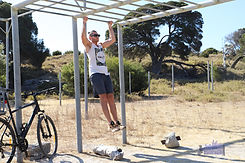
Kingston Barracks Facilities
Army Assault Course
Previously known as a Training Area on an undated 1950s Department of Army map as well as a Confidence Course on a 1974 HQ 5 MD map, it seems to have originally been known as the Army Assault Course.
Decorative gates bearing the initials KB in a circle was installed at the entrance of Kingston Barracks, where the assault course is on the left and the D.I.D. Store on the right. The brick brick pillars they were attached to, were demolished when the Army relinquished the barracks and the gates are said to have remained in storage on the island ever since.
The Rottnest Island Obstacle Course or Assault Course were the typical design used by the Australian Army for well over 100 years. An "effective form of military team training" where obstacles are arranged in a straight line so teams can compete against each other for the fastest time.
I just had to stop and take photos of local resident Thomas doing his chin-up training on the Army Assault Course, although he'd pretty much finished up but kindly did one last one for me. There was something about watching him that made it so awesome (not just because he's a good looking, strong guy!)
It really helped to imagine the soldiers doing chin ups and using the facilities back in the day, making it feel so much more surreal and important. Even if it was just an assault training course.
Unfortunately it looks like I've accidently lost some of the info Thomas told me but if my memory serves me right, which occasionally it does, he was a traveller who'd been living and working on the island for a number of years. I think he said he was Spanish and in his mid-30's.






D.I.D. Store & P-Hut
The Detail Issue Depot Store (D.I.D.) is often referred to as the Railway Station on a number of maps and plans. These facilities were used for "storing and distributing basic supplies to the various camps and units in their areas of responsibility", hence the railway line which serviced the DID Store.
Coast Defence Museum
Conveniently located next to the start of the Bickley walk trail, a short ride from Settlement and serviced by the Island Explorer, it's set to become the new Coast Defence Museum, which is expected to "enhance the defence heritage experience" available to visitors. Extensive conservation works have been undertaken on a Bofors Anti-Aircraft Gun, which will center as a prominant feature. The gun will be presented by members of the 116th Light Anti-Aircraft Regiment (2nd AIF) Association (p.10), "to commemorate the Regiment's Service on Rottnest Island between 1942-1943".
Unfortunately, it appears that the project is yet to be realised, due to funding as always. If you can help the Rottnest Foundation achieve their goals, visit their website or donation page.
During their recent March 2025 Board Meeting, which was held on the island, it was revealed that the Rottnest Island Authority had invested a significant financial amount. This will enable the Rottlest Foundation to develop site assessments, concept designs and costings" for a number of their projects, including the new Coast Defence Museum, which is part of the Bickley Military Heritage Precinct project.
P-Huts
P-Huts were initially designed and constructed for the military's personnel accommodation requirements, centered around sleeping or stores. They were then modified for "messes, guard huts, canteens medical aid posts, dental surgeries, recreation huts, classrooms and offices"
A number of online resources refers to the D.I.D. shed followed with "P-Hut", despite the Army Museum WA stating in an article that there doesn't appear to be an example of a "Standard wartime P1 Hut remaining". Current photos of the D.I.D. show a much higher raised foundation than the WW2 photos presented in the article.
Upon looking at a number of old site layouts, it appears that a building was once closely located in a south-east direction to the D.I.D. Store, which may have very well been the P-Hut as mentioned on the State Heritage website. Whatever the building was, had been demolished sometime before 1955.













M.O.B. Store
The MOB store was used to store military equipment.
A smaller building, some 10 metres south of the warehouse, was the RAA Store. Another small building a further 10 metres south of the RAA Store, was located in between the road and the railway line.
Both buildings were demolished some time before 2000.








Building 15 - RAAF Wireless Station
Most maps and plans refer to this small building as an Old Concrete Building.

.png)

